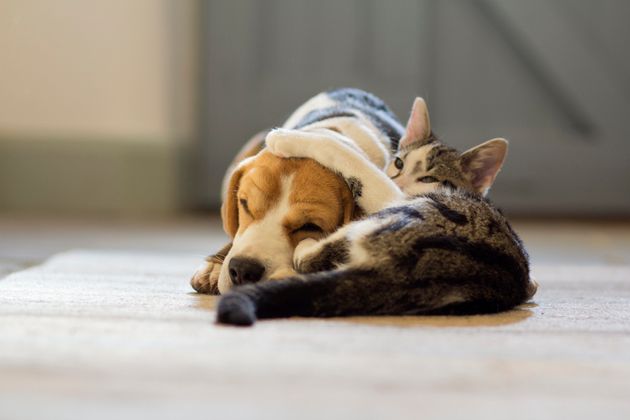"Their brains are telling them that they love us."

Getty Images
The never-ending cat vs. dog debate has a new topic that fans of both
species can chew on/paw at: which pet loves its humans more?
Thanks to a new study done by neuroscientist Dr. Paul Zak, which will be featured in the BBC2 documentary show, Cat v. Dog, we have answer.
Canines were proven to love us Homo sapiens five times more than their feline counterparts.
But unlike commands like “stay,” “sit” and “beg,” the result isn’t that simple. Much like a cat, it’s way more complex.
Zak took blood samples from 10 cats and 10 dogs before and after they played with their people. He tested each animal twice and checked the samples for their level of oxytocin.
“Oxytocin is an attachment neurochemical or transmitter,” Zak told The Huffington Post. “It’s a chemical we produce in our brain when we care about someone. It’s what mammals release to bond with their young.”
Thanks to a new study done by neuroscientist Dr. Paul Zak, which will be featured in the BBC2 documentary show, Cat v. Dog, we have answer.
Canines were proven to love us Homo sapiens five times more than their feline counterparts.
But unlike commands like “stay,” “sit” and “beg,” the result isn’t that simple. Much like a cat, it’s way more complex.
Zak took blood samples from 10 cats and 10 dogs before and after they played with their people. He tested each animal twice and checked the samples for their level of oxytocin.
“Oxytocin is an attachment neurochemical or transmitter,” Zak told The Huffington Post. “It’s a chemical we produce in our brain when we care about someone. It’s what mammals release to bond with their young.”
According to Zak, humans
produce oxytocin whenever we have a positive experience, and the amount
we produce is contingent on how stressful our situations are when we
have that positive interaction.
A general breakdown, according to Zak is that we produce 15 to 25 percent oxytocin when we have a pleasant interaction with a stranger; 25 to 50 percent when we’re engaging with someone we know; and if we release 50 percent or more, it’s in response to someone we really love like a child or spouse.
During Zak’s experiment, dogs, on average, produced 57.2 percent.
“So your dog really loves you … a lot,” Zak said. “But what makes this so amazing is that the oxytocin they produced is for another species, not their own. The fact that this is cross species is really freakin’ crazy/cool. Their brains are telling them that they love us.”
A general breakdown, according to Zak is that we produce 15 to 25 percent oxytocin when we have a pleasant interaction with a stranger; 25 to 50 percent when we’re engaging with someone we know; and if we release 50 percent or more, it’s in response to someone we really love like a child or spouse.
During Zak’s experiment, dogs, on average, produced 57.2 percent.
“So your dog really loves you … a lot,” Zak said. “But what makes this so amazing is that the oxytocin they produced is for another species, not their own. The fact that this is cross species is really freakin’ crazy/cool. Their brains are telling them that they love us.”
When asked if the cats would have done better if they were tested in the comfort of their own homes, Zak said, "I think so. Or at least more cats would have produced more oxytocin."
When it comes to Zak’s pet preference, however, he’s clearly Team Dog. He adopted a black and white puppy named Cookie after his daughter discovered the stray in their garage a few years ago.
And if it weren’t for the research he’s conducted in regards to the amount of love dogs have for their humans, he says he might have not kept sweet, little Cookie.
“If it weren’t for the research we started three years ago, I wouldn’t have let my kid play with an animal we didn’t know within two seconds of meeting it,” he said. “But now I know it’s crazy how much they care about you. And isn’t that cool?”


No comments:
Post a Comment